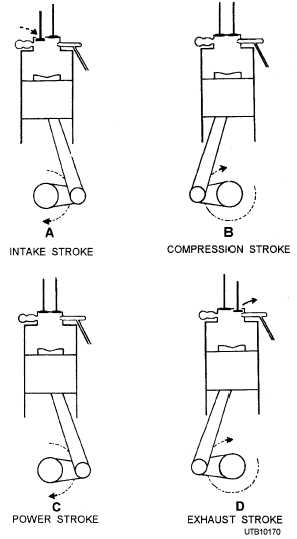According to the prescribed maintenance schedules, the engine operator performs other inspections and maintenance duties. These main- tenance routines occur at timed intervals prescribed by manufacturers. Examples of tasks that can be required by a maintenance schedule are as follows:
Removing and cleaning the oil filterelements
Inspecting the fuel lines, the fuel filters, and the fuel pump
Cleaning the battery casings and the terminal posts; checking for proper electrolyte level and specific gravity
Inspecting and lubricating the starting mechanism
Inspecting, cleaning, and lubricating the generator; inspecting and testing the voltage and current regulator
Inspecting the radiator; inspecting the water pump, the fan, and the drive belts
Disassembling and cleaning the air filters and the breather caps
Inspecting the crankcase, the valve covers, the timing gears, and the clutch housing Inspecting the cylinder heads and the gaskets 6-7
Operation and Maintenance of Gasoline Engines
Like the diesel engine, the gasoline engine changes heat energy into mechanical energy. The physical construction of the gasoline engine is very much the same as that of the diesel. Pistons, cylinders, valves, connecting rods, a crankshaft, and an engine block are in each. A cooling system carries heat away; a lubrication system reduces friction of moving parts; an air system supplies air for combustion in the cylinders; and a fuel system supplies fuel.
Most gasoline engines operate on the four-stroke cycle (fig. 6-5). The difference between gasoline and diesel engine operation is the method of introducing the fuel and the air into the cylinders and the means by which the compressed fuel and air are ignited in the cylinders.
In a diesel engine, the air is admitted to the cylinder on the intake stroke of the piston, as shown in view A, figure 6-5. The fuel oil is sprayed into the chamber AFTER the air has been compressed. In a gasoline engine, the fuel (gasoline) and air are mixed together BEFORE being admitted to the cylinder. The intake

Figure 6-5. - Four-stroke cycle.
stroke of the piston sucks air through the air cleaner into the carburetor. In the carburetor, the clean air is mixed with gasoline (vaporized) from the fuel tank. The air and gas mixture continues on to the intake manifold that is connected to the cylinder head. An intake valve admits the air-gas mixture into the cylinder.
The diesel engine produces combustion by using the heat of compression, as shown in view B. In a gasoline engine, an electric SPARK is provided by the spark plug to ignite the air-gas mixture. Ignition occurs as the piston completes its compression stroke. The ignited gases expand and the piston is pushed down on the power stroke, as shown in view C. The exhaust stroke of the piston forces the burned gases out of the cylinder chamber, as shown in view D.
The operating procedures and operator maintenance routines for gasoline engines are essen- tially the same as those for diesel engines. Starting
Continue Reading